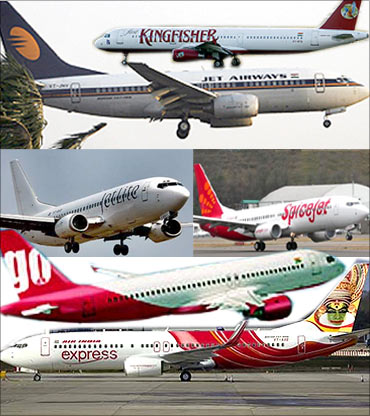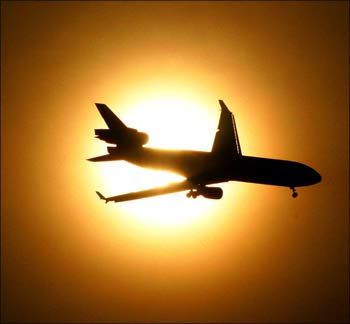 | « Back to article | Print this article |
Lower airfares further, govt tells airlines
Talking tough, the government on Monday asked the airlines to rationalise the level of airfares, saying it was not fully satisfied with the steps they have taken so far to lower the tariff rates.
After a meeting of the newly-formed Civil Aviation Economic Advisory Council, Civil Aviation Minister Praful Patel said, "Astronomical fares need to be controlled. We have already advised the airlines to do further more (in this regard)."
Maintaining that the government "cannot be a mute spectator" to the airlines charging exorbitant fares, he said that "we are not fully satisfied" with the steps taken by the airlines so far. "Spot fares (last moment tariff) cannot be unreasonable," the minister said.
The Directorate General of Civil Aviation and the ministry have already issued directives to the domestic carriers to maintain transparency in airfares so that passengers are aware what price they would be charged if they travel on a particular sector on a given date, he said.
Indicating that the airlines should take the measures recommended by DGCA within a given "time-frame", Patel said in reply to questions that the DGCA could take "further action" under Rule 135 of Aircraft Rules, which deals with transparency in publishing of airfares.
Click NEXT to read on . . .
Lower airfares further, govt tells airlines
Following the directives of the DGCA, the airlines had brought down tariffs by 20-25 per cent. The regulator had asked the airlines to ensure transparency by keeping passengers informed about the fares available sector-wise and date-wise in layman's language.
The CAEAC, at its meeting, decided to set up a small working group, comprising representatives of the air carriers and passengers' associations, to recommend measures to "ensure transparency" in fixing of airfares, keeping the DGCA directives in mind.
Patel stressed that interests of both passengers and airlines are maintained and added that passengers should not be troubled during the upcoming holiday and festive season.
This working group would meet in the next fortnight and the CAEAC would meet in January to further review the situation, the minister said.
The CAEAC was set up following a surge in airfares in November without any increase in operational costs, to advise the ministry on all financial policy issues and recommend a road-map to boost investment in the sector.
Click NEXT to read on . . .
Lower airfares further, govt tells airlines
At the meeting chaired by civil aviation secretary S N A Zaidi, a presentation was made on the economic health of the Indian aviation industry.
Besides Zaidi and other officials of the ministry, CEOs of several airlines and airport operators, representatives of International Air Transport Association and industry associations like Federation of Indian Airlines, CII, Ficci and Assocham, representatives of consumer fora and travel agents also attended the meeting.
A-Pac region sees steep hike in airfares
The steep hike in airfares witnessed in India recently has been replicated in the Asia-Pacific region too as airlines threw "caution to the wind" in raising tariff even as passenger traffic grew substantially, according to a latest study.
As air traffic rebound strongly in the Asia-Pacific region after the downturn, airlines started charging higher fares making air travel costlier, said the American Express Business Travel Monitor in its study on airfare trends in the region released on Monday.
"Airlines initially were cautious in their response to raising airfares. However, during the later part of the third quarter of this year up until now, more and more airlines are throwing caution to the wind and it's becoming more expensive for travellers to fly as a result," vice president of global business partnerships and advisory services for AEBT Robert Tedesco said.
Click NEXT to read on . . .
Lower airfares further, govt tells airlines
He pointed out that airlines were reducing availability of discounted seats even as the demand picked up. "This has also made travelling more of an expense for both corporations and leisure travellers," he said.
Analysing the study, Tedesco said he believed that the airlines' current strategy to limit capacity below traveller demand has contributed to price increases and this would continue to do so in the short term.
"This is particularly true for national carriers throughout the region, which have been able to raise fares more quickly than smaller carriers given their market dominance," he said.
The American Express Monitor's analysis of the Asia-Pacific region as a whole showed year-over-year price increases across all class categories at an average of 2 per cent.
The prices in the third quarter remained steady compared with those during the second. "Airlines across the region, particularly the dominant carriers, increased fares towards the end of the third quarter," the study said.



